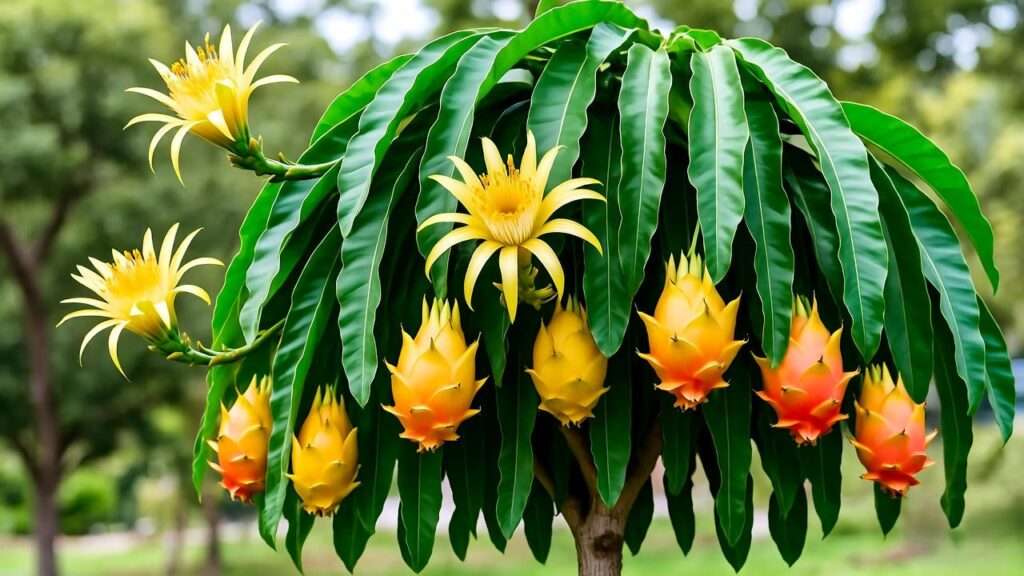Imagine harvesting sweet, golden-yellow dragon fruit from your own backyard, their vibrant skins glowing under the sun and their juicy flesh bursting with flavor. The yellow dragon fruit tree (Hylocereus megalanthus) is a tropical treasure that’s capturing the hearts of gardeners worldwide. Whether you’re a beginner dreaming of a lush garden or a seasoned grower aiming for a bountiful harvest, this guide is your roadmap to success. Packed with expert insights and practical tips, we’ll walk you through every step of growing a thriving yellow dragon fruit tree, from planting to harvesting. Let’s dive into the world of this exotic cactus and transform your garden into a tropical paradise! 🌴
1. Understanding the Yellow Dragon Fruit Tree 🌵
1.1 What Makes the Yellow Dragon Fruit Tree Unique? ✨
The yellow dragon fruit tree, scientifically known as Hylocereus megalanthus, is a climbing cactus native to South America, particularly thriving in regions like Colombia and Ecuador. Unlike its red or white dragon fruit cousins, the yellow variety boasts smaller, bright yellow fruits with a sweet, kiwi-like flavor and creamy white flesh speckled with tiny black seeds. Its nocturnal flowers are a sight to behold—large, fragrant, and blooming under moonlight. According to horticultural experts, this species is prized for its adaptability to various climates and its nutrient-packed fruit, rich in vitamin C, antioxidants, and dietary fiber.
1.2 Why Choose a Yellow Dragon Fruit Tree for Your Garden? 🌿
Why grow a yellow dragon fruit tree? Beyond its delicious fruit, this plant is a showstopper. Its sprawling, cactus-like vines create a stunning visual, perfect for trellises or garden walls. It’s also space-efficient, thriving in containers for urban gardeners or small patios. The fruit’s versatility shines in smoothies, salads, or even grilled desserts, making it a favorite for health-conscious foodies. Plus, its low-maintenance nature makes it an ideal choice for busy gardeners who want high rewards with minimal fuss.
2. Ideal Growing Conditions for Yellow Dragon Fruit Trees ☀️
2.1 Climate and Temperature Needs 🌡️
Yellow dragon fruit trees thrive in warm, tropical, or subtropical climates, with ideal temperatures between 65°F and 90°F. They flourish in USDA hardiness zones 9–11, though they can tolerate brief dips to 32°F with protection. In cooler climates, consider growing them indoors or in a greenhouse with grow lights. To mimic their native environment, ensure consistent warmth and avoid prolonged exposure to frost, which can damage stems.
2.2 Soil Requirements 🏜️
Well-draining soil is non-negotiable for yellow dragon fruit trees. A sandy or loamy mix with a pH of 6.0–7.5 works best. If your soil is heavy or clay-based, amend it with perlite, sand, or organic matter like compost to improve drainage. Poor drainage can lead to root rot, a common issue for cacti. Test your soil’s pH annually using a home testing kit, and adjust with sulfur or lime if needed.
2.3 Sunlight and Location 🌞
These sun-loving plants crave 6–8 hours of direct sunlight daily. Choose a south-facing spot in your garden or patio to maximize exposure. If planting near a wall or fence, ensure it’s sturdy enough to support a trellis or post, as the vines can grow heavy with fruit. Avoid windy areas, as strong gusts can snap delicate stems. For container plants, rotate pots every few months to ensure even light distribution.
3. Planting Your Yellow Dragon Fruit Tree 🌱
3.1 Selecting Healthy Cuttings or Plants 🌿
Start with high-quality cuttings or potted plants from a reputable nursery or online supplier specializing in tropical plants. Look for firm, green stems at least 12–18 inches long for cuttings, or established plants with healthy roots. Avoid any with soft, brown, or shriveled sections, as these may indicate rot or pest damage. Local agricultural extension services often recommend sourcing from certified growers to ensure disease-free stock.
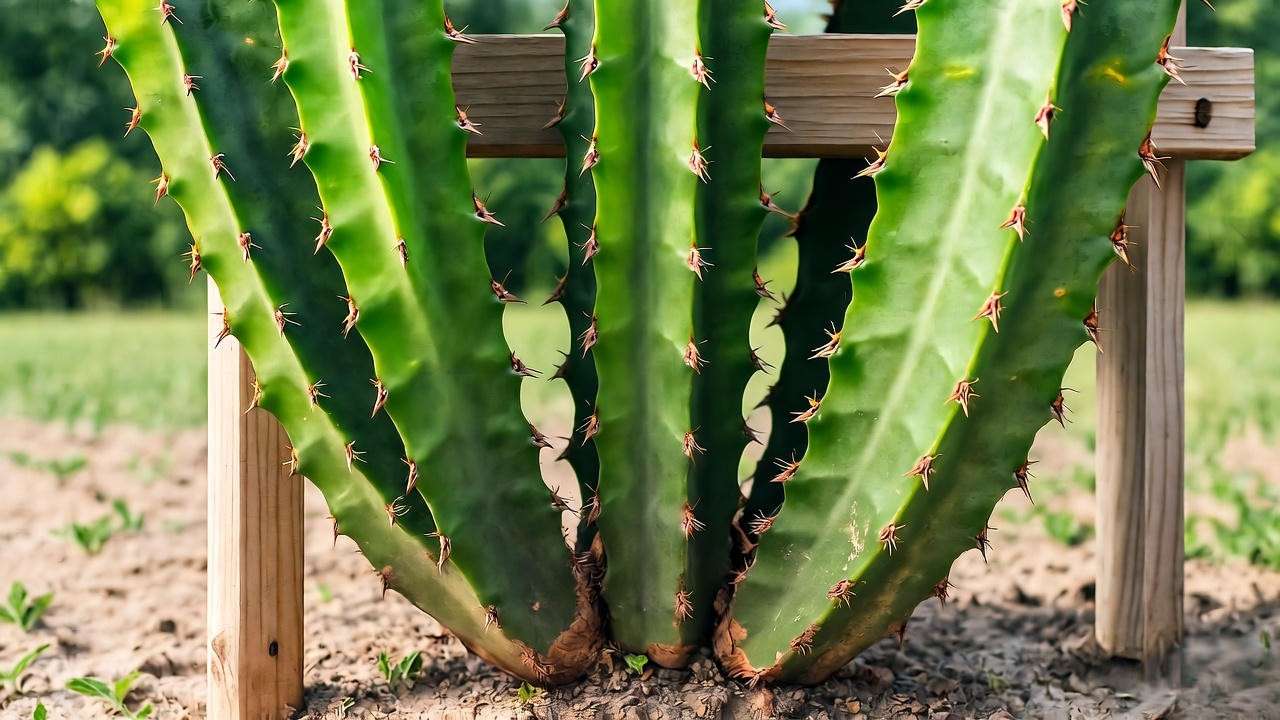
3.2 Step-by-Step Planting Guide 📋
- Prepare the Site: Choose a location with full sun and good drainage. If planting in-ground, dig a hole twice the width of the root ball or cutting base. For containers, select a pot at least 15–20 gallons with drainage holes.
- Add Support: Install a sturdy trellis, post, or fence before planting, as the vines will need support as they grow. A 4–6-foot post with a circular frame works well.
- Plant the Cutting or Plant: For cuttings, bury the bottom 2–4 inches in soil, ensuring the cut end is calloused. For potted plants, place at the same depth as in the nursery pot. Space multiple plants 6–8 feet apart.
- Water Lightly: Water sparingly after planting to settle the soil, then wait a week before watering again to encourage root establishment.
- Best Time: Plant in spring or early summer in warm climates for optimal growth.
3.3 Container Growing for Small Spaces 🪴
For urban gardeners, container growing is a game-changer. Use a pot with a diameter of at least 18 inches and ensure it has drainage holes to prevent waterlogging. A mix of 50% potting soil, 25% sand, and 25% perlite mimics the plant’s natural habitat. Place the pot on a wheeled base for easy movement, especially in cooler climates where you may need to bring it indoors during winter. Ensure the container gets ample sunlight and check drainage regularly.
4. Caring for Your Yellow Dragon Fruit Tree 🌼
4.1 Watering Needs 💧
Yellow dragon fruit trees prefer a “soak and dry” approach. Water deeply when the top 2 inches of soil feel dry, typically every 7–10 days in warm weather. Reduce watering in cooler months or during dormancy (late fall to winter). Overwatering is a common mistake—soggy soil can lead to root rot. Signs of overwatering include yellowing or mushy stems, while underwatered plants may have shriveled, dry stems. Use a moisture meter for precision if you’re unsure.
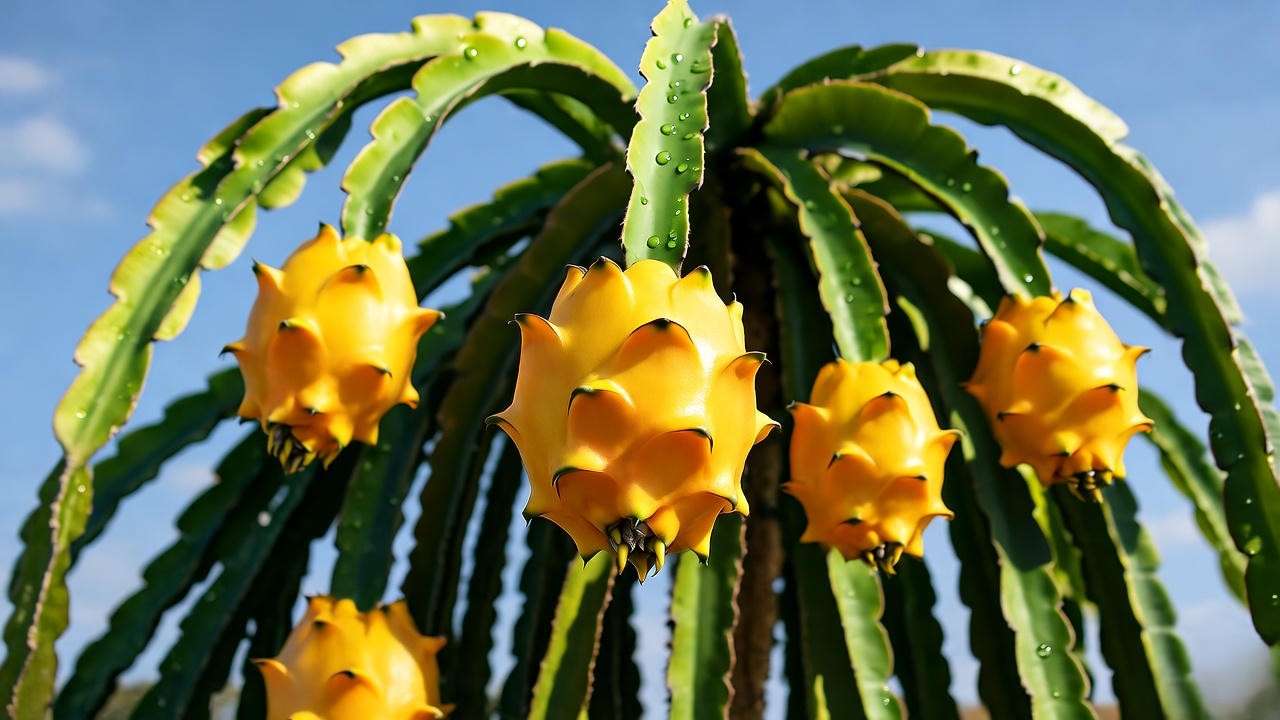
4.2 Fertilizing for Optimal Growth 🌱
To fuel vibrant blooms and fruit, use a low-nitrogen, high-potassium fertilizer (e.g., 8-4-12 or 10-10-10) during the growing season (spring to summer). Apply monthly, following package instructions, and dilute liquid fertilizers to half-strength to avoid burn. Organic options like compost tea, worm castings, or fish emulsion are excellent for eco-conscious gardeners. Avoid fertilizing in winter when the plant is dormant. A soil test every 1–2 years can help fine-tune nutrient levels.
4.3 Pruning and Training ✂️
Pruning keeps your yellow dragon fruit tree manageable and productive. In late winter or early spring, remove dead, damaged, or overcrowded stems to improve airflow and light penetration. Train vines by gently tying them to a trellis or post with soft plant ties, encouraging upward growth. Limit the number of main stems to 2–3 per plant for optimal fruit production. Regular pruning also prevents the plant from becoming too heavy for its support structure.
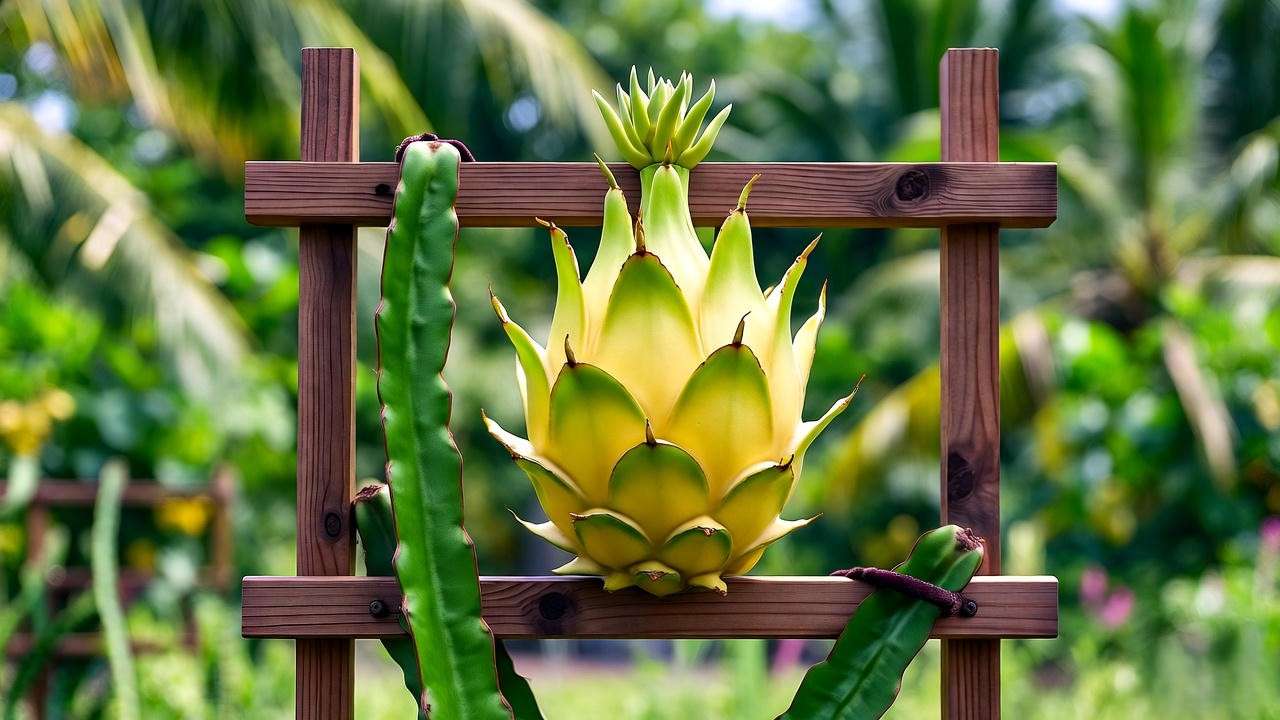
4.4 Pollination for Abundant Fruit 🐝
Yellow dragon fruit trees produce large, white flowers that bloom at night, relying on moths or bats for natural pollination. In areas with low pollinator activity, hand-pollination boosts fruit yield. To hand-pollinate:
- Identify open flowers at dusk or dawn.
- Use a soft brush or cotton swab to collect pollen from the stamen.
- Transfer pollen to the stigma of the same or another flower.
- Repeat for multiple flowers to ensure success.
Pollination is most effective in warm, humid conditions. Expect fruit to develop within 30–50 days after successful pollination.
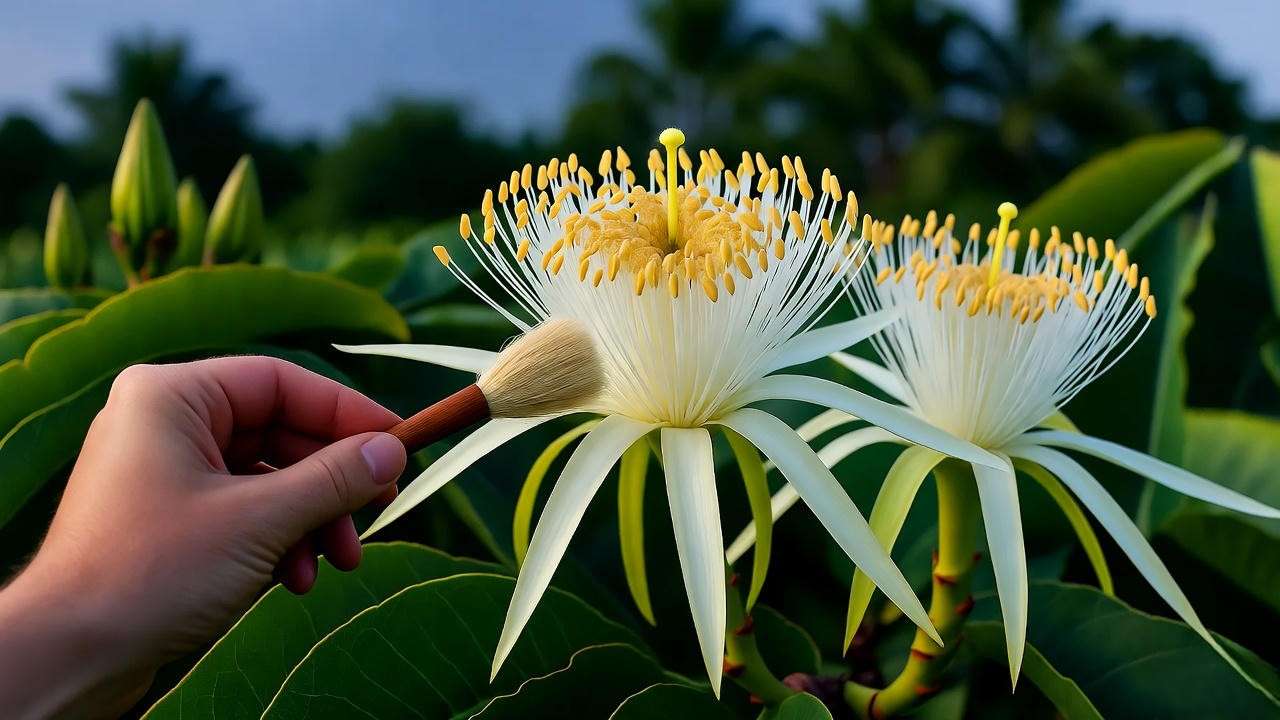
5. Common Challenges and Solutions 🛠️
5.1 Pests and Diseases 🐛
Yellow dragon fruit trees are relatively hardy, but they can face pest and disease issues. Common pests include aphids, mealybugs, and scale insects, which suck sap from stems and weaken the plant. Inspect your tree regularly for sticky residue or small, clustered bugs. For organic control, spray a mixture of neem oil and water (1 tsp per quart) every 7–10 days until pests are gone. Alternatively, introduce beneficial insects like ladybugs to keep aphid populations in check.
Fungal issues like root rot and stem rot are often caused by overwatering or poor drainage. To prevent root rot, ensure your soil drains well and avoid letting water pool around the base. If you notice soft, brown stems, cut away affected areas with a sterilized knife and apply a copper-based fungicide. Always disinfect tools between cuts to prevent spreading pathogens. According to university extension programs, maintaining proper soil moisture and airflow is key to avoiding fungal problems.
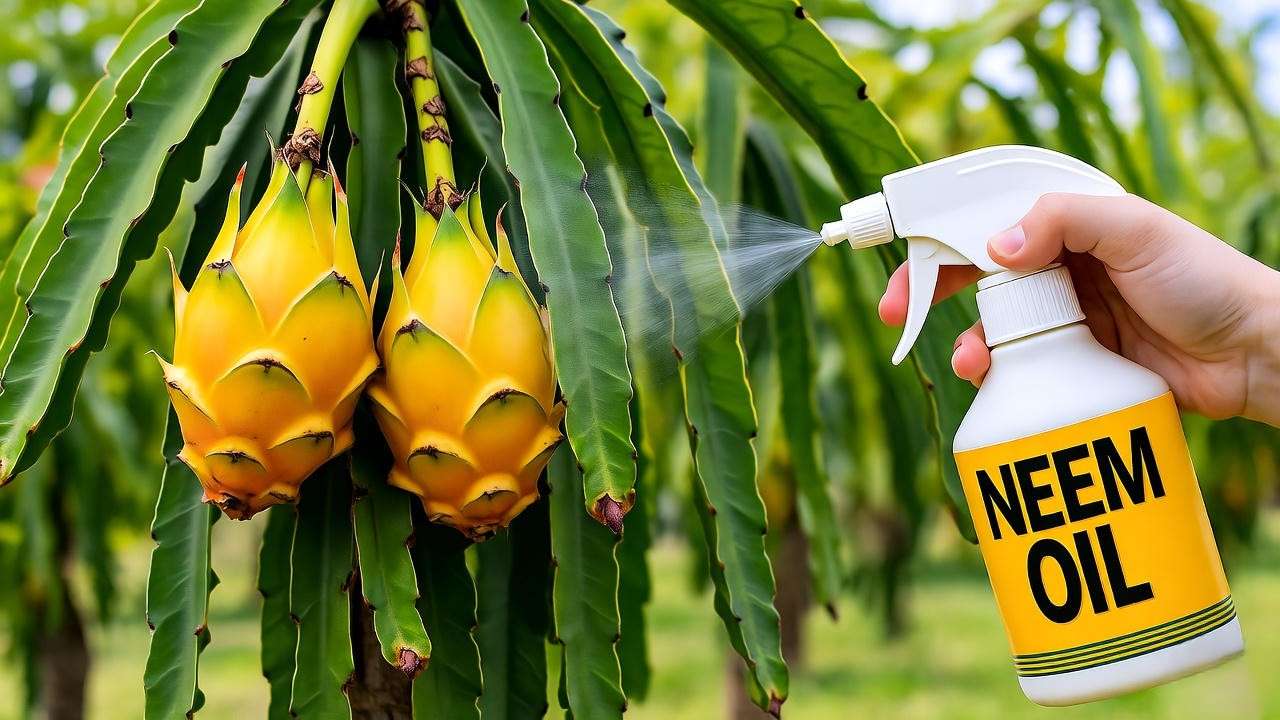
5.2 Environmental Stress 🌪️
Extreme weather can stress yellow dragon fruit trees. In scorching heat (above 100°F), provide partial shade during the hottest part of the day using shade cloth or temporary covers. In colder climates, protect plants from frost by wrapping stems with burlap or moving container plants indoors. Windy conditions can snap fragile stems, so install windbreaks or plant near a natural barrier like a fence. Yellowing stems may indicate sunburn or nutrient deficiencies—relocate the plant or adjust fertilization accordingly.
5.3 Troubleshooting Low Fruit Production 🍎
If your yellow dragon fruit tree isn’t producing fruit, several factors could be at play:
- Pollination Issues: Lack of pollinators or unsuccessful hand-pollination can result in flower drop. Increase pollination success by hand-pollinating multiple flowers and ensuring humid conditions.
- Nutrient Imbalance: Too much nitrogen promotes leafy growth over fruiting. Switch to a high-potassium fertilizer to encourage blooms.
- Insufficient Light: Less than 6 hours of sunlight daily can reduce flowering. Relocate the plant or trim nearby obstructions.
- Young Plant: Cuttings may take 1–2 years to bear fruit, while established plants fruit within 6–12 months. Be patient and maintain consistent care.
6. Harvesting and Enjoying Your Yellow Dragon Fruit 🍈
6.1 When and How to Harvest 🪓
Yellow dragon fruit is ready to harvest when the skin turns a vibrant, uniform yellow and the fruit gives slightly when squeezed. This typically occurs 30–50 days after pollination, depending on climate and care. To harvest, gently twist the fruit or use clean pruning shears to cut it from the stem, avoiding damage to the vine. Harvest in the morning for the best flavor, as sugars are concentrated after cooler nights. Handle fruits carefully to prevent bruising, which can affect storage life.
6.2 Storing and Using Your Harvest 🥗
Fresh yellow dragon fruit can be stored at room temperature for 3–5 days or refrigerated for up to 2 weeks. For longer storage, scoop out the flesh, freeze it in airtight bags, and use it for smoothies or desserts. The fruit’s sweet, mildly tangy flavor pairs well with tropical fruits like mango or pineapple. Try these recipes:
- Dragon Fruit Smoothie: Blend yellow dragon fruit flesh with banana, coconut milk, and a splash of lime juice.
- Tropical Fruit Salad: Combine diced dragon fruit with kiwi, papaya, and a drizzle of honey.
- Dragon Fruit Sorbet: Puree the flesh with sugar syrup, freeze, and churn for a refreshing treat.
Preserve excess fruit by making jams or drying slices for snacks. The seeds are edible and add a subtle crunch to dishes.
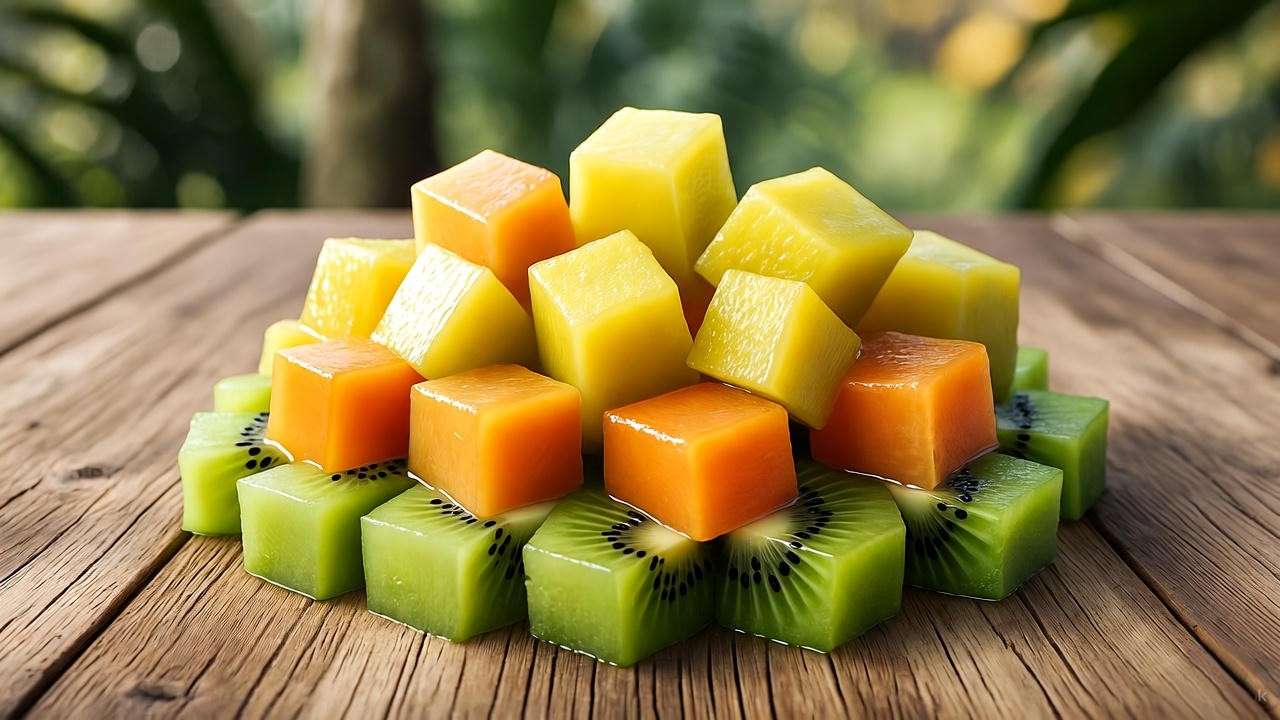
7. Expert Tips for Long-Term Success 🌟
- Tip 1: Rotate container-grown yellow dragon fruit trees every 2–3 months to ensure even sunlight exposure, promoting balanced growth.
- Tip 2: Apply a 2-inch layer of organic mulch, like bark or straw, around the base to retain moisture and regulate soil temperature. Keep mulch 2 inches from the stem to prevent rot.
- Tip 3: Test soil pH annually and adjust to maintain the 6.0–7.5 range, as improper pH can hinder nutrient uptake.
- Expert Insight: Dr. Maria Lopez, a tropical fruit specialist at the University of Florida, recommends, “Prune yellow dragon fruit trees annually to maintain 2–3 main stems. This focuses the plant’s energy on fruit production, yielding larger, sweeter fruits.”
- Seasonal Care Calendar:
- Spring: Plant cuttings, fertilize monthly, and begin training vines.
- Summer: Water regularly, hand-pollinate flowers, and monitor for pests.
- Fall: Reduce watering, harvest ripe fruit, and prepare for dormancy.
- Winter: Prune lightly, protect from cold, and pause fertilization.
8. FAQs About Yellow Dragon Fruit Tree Care ❓
- How long does it take for a yellow dragon fruit tree to bear fruit? Cuttings typically fruit in 1–2 years, while established plants may produce in 6–12 months with proper care.
- Can I grow a yellow dragon fruit tree indoors? Yes, with 6–8 hours of bright light (grow lights if needed) and a warm environment (65–80°F).
- Why are my dragon fruit flowers dropping? This may be due to poor pollination, excessive heat, or nutrient deficiencies. Hand-pollinate and ensure adequate potassium.
- What’s the best support structure for a yellow dragon fruit tree? A 4–6-foot post with a circular frame or a sturdy trellis works best to support heavy vines.
- How do I propagate a yellow dragon fruit tree? Take 12–18-inch cuttings, let them callous for 5–7 days, and plant in well-draining soil. Seeds are possible but slower and less reliable.
9. Conclusion: Grow Your Own Tropical Paradise 🌴
Growing a yellow dragon fruit tree is a rewarding journey that brings exotic beauty and delicious fruit to your garden. With its striking flowers, space-saving growth, and nutrient-rich harvest, this tropical cactus is a must-have for plant enthusiasts. By following this guide—covering planting, care, troubleshooting, and harvesting—you’re equipped to cultivate a thriving tree, whether in a sprawling backyard or a cozy patio pot. Start today, share your progress in the comments, and explore our other plant care guides for more gardening inspiration. Your tropical paradise awaits! 🌿

